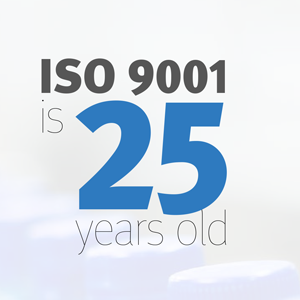ISO 9001 has just been updated! In the world of global quality management, this is an exciting event and important news for well over one million ISO 9001-certified organizations worldwide, and for the millions more individuals who use ISO’s famous quality management system standard (QMS) daily to facilitate trade. The latest 2015 revision, just published, gives the “jewel” of quality management a fresh sparkle, keeping it relevant and bringing it right up to date with today’s connected world.

Introduced in 1987, ISO 9001 has been revised four times to date, and the new version – ISO 9001:2015 – is the first major revision since 2000. It has been three years in the making and is the work of hundreds of experts from industry and commerce, standards stakeholders (i.e. consultants, users, test laboratories, certification bodies, etc.), academia and research bodies, government, NGOs, representing 81 ISO member bodies around the world, as well as many thousands of participants in the national mirror committees who reviewed and commented on the draft standard during its development. The result of this evolutionary process brings ISO’s best-selling standard firmly into the 21st century.
Certified organizations have three years following publication of ISO 9001:2015 in September to align their quality management systems to the new edition of the standard, although it is hoped they will not wait until the last minute to benefit from the significant changes in the latest version.
“It’s a game changer!”
Early feedback from reviewers and users of the standard has been very positive. “It’s a game changer,” says Simon Feary, Chief Executive at the Chartered Quality Institute in the UK. Alan Daniels of Boeing, who represented the International Aerospace Quality Group on the ISO 9001 revision subcommittee, sees it as “a real improvement that will lead to a more robust QMS”. “This is a wonderful opportunity for organizations to refocus their QMS on their business operations,” concludes Sheronda Jeffries of Cisco Systems, representing QuEST Forum, a global quality organization for the telecom (ICT) community. As for Mark Braham of the Automobile Association (United Kingdom), he believes ISO 9001:2015 will have huge impacts across the world, while Luiz Nascimento of the Brazilian Association of Technical Standards (ABNT) thinks it will provide more confidence that quality management systems really do work.
Why change?
Many users, happy with ISO 9001 in its current form, may well ask “if it isn’t broken, why fix it?” But this latest revision is a response to vast changes in technology, business diversity and global commerce in the 15 years since ISO 9001:2000.

ISO 9001:2015 recognizes the increased prominence of the service sector and its need for quality management. It also reflects calls for greater QMS alignment and integration with an organization’s business and strategic direction, and makes it easier to adopt multiple ISO business management standards such as ISO 14001 and sector-specific QMSs such as the aerospace industry’s AS9100.
Representing the aerospace industry view, Alan Daniels also highlights changes in business models, more complex supply chains, and increased customer expectations as further compelling reasons for adapting the standard to a changing world. He believes ISO 9001 must enhance an organization’s ability to satisfy its customers while reflecting the increasingly complex environments in which they operate. It should also recognize the needs of all interested parties and align with other management systems – hence the call for extensive and detailed revision.
Have the changes been successful? In the opinion of Anni Koubek, Head of Innovation, Quality Austria, the 2015 version of the standard “clearly fits the global, dynamic, complex, networked and IT-driven business environment most organizations have to operate in much better than the 2008 version”.
What has changed?
The first piece of good news is that ISO 9001:2015 will be easier to use, particularly in conjunction with other management system standards, and will be less prescriptive – for example, documentation will be less mandated and more user-friendly, and the language has been simplified. It also follows the underlying philosophy that “output matters”, so it will ask if an organization’s processes are achieving their planned results, and if the system is actually delivering on its promise – central to implementing ISO 9001 – of “providing confidence in the ability to consistently provide conforming products and services”, explains Nigel Croft, Chair of the ISO subcommittee that revised the standard.

“ISO 9001:2015 is very much performance-based, with a focus on has to be achieved rather than to achieve it,” he adds. The new version combines the successful “process approach” with a new core concept of “risk-based thinking” to prioritize the processes, employing the Plan-Do-Check-Act (PDCA) cycle at all levels in the organization to manage the processes and the system as a whole, and to drive improvement. This new risk-based focus is intended to prevent undesirable outcomes such as non-conforming products and services.
The 2015 version adopts a new high-level structure for ISO management systems standards – based on Annex SL of the consolidated ISO Supplement to the ISO/IEC Directives. It is expected to have a significant impact on organizations, trainers, consultants, certification and accreditation bodies, auditors and standards writers. Annex SL provides identical structure, text and common terms and definitions for all future ISO management system standards (MSSs), giving each a similar “look, touch and feel” and making implementing multiple standards within one organization easier. Now, all new ISO MSSs will follow this framework to ensure consistency and compatibility, ending some earlier confusion during implementation.
Mark Braham, CQI Category A liaison in ISO/TC 176, Quality management and quality assurance, sees “huge benefit” in following the Annex SL framework to integrate other management system standards, and help reduce management time and effort to meet requirements, while Sheronda Jeffries says that the inclusion of the new annex will better allow organizations to see the differences and similarities of ISO 9001:2015 with other MSSs.
How will the changes benefit you?

“ISO 9001:2015 recognizes the importance of the organization’s business in terms of the type of products and services it provides, their criticality, and the external and internal factors that affect the way it works,” says Nigel Croft. The latest version obliges each organization to think about its own particular circumstances, rather than prescribing a “recipe” for how to design the quality management system. Organizations will therefore have greater flexibility in the way they choose to implement the standard, and the amount and nature of the documentation that is required.
One very important factor has been the greater alignment of structure, content and terminology for all ISO management system standards, particularly evident when looking at the new versions of ISO 9001 and ISO 14001, he says, alluding to Annex SL. This is intended to make life easier for organizations needing to address the requirements of several standards in a single management system.
Assets of risk-based thinking
According to Alan Daniels, the new version will lead to a more robust QMS because it links the process approach with PDCA and risk-based thinking, and connects the QMS to strategic planning and the business processes. “Identifying risks adds value and opportunities for improvement, and the engagement of top management enhances the chance of success on all levels.” For Sheronda Jeffries, introduction of the term “risk-based thinking” along with the term “risks and opportunities” will encourage an organization to be more proactive.
“Risk-based thinking will help organizations make business decisions based on risk by providing the structure to manage it,” says Lorri Hunt of US-based quality management system training, auditing and consulting firm Lorri Hunt & Associates Inc. Anni Koubek also views it as the most important change in the new 2015 version, although she adds that it is not one single element that makes this standard different from the 2008 version; “it is the consequent orientation on results and a certain flexibility on how to build the management system that can be seen throughout the standard”.
Involving the leadership
For Simon Feary, the most significant change is the switch from management commitment to leadership and commitment, embedding responsibility for the operation and performance of the QMS at levels of the organization. The requirements for greater senior management involvement will put the quality profession in front of senior management like never before, he claims. Whether delivering quality management programmes or auditing against management system standards, he urges quality professionals to seize the opportunity to develop new skills and add greater value to their organizations.

The new emphasis on top management involvement is one of the most important changes for Mark Braham, particularly as “they must do tasks to meet the requirements and cannot delegate”. Lorri Hunt interprets the focus on leadership as a transition from the implication of one management representative being responsible for the QMS to the philosophy of a system owned by all of the leadership.
This top-down approach will significantly raise the status of ISO 9001 in the eyes of senior management, believes Leopoldo Colombo, Executive Director of the Quara Group, a Latin American management consulting and training organization. He thinks the days when quality managers would be thanked for their QMS status presentations and then asked to leave the meeting because “we have business to discuss” are over! “Version 2015 has set the requirements and anchorages needed to ensure that the QMS will be strongly integrated with the organization’s business and aligned with its strategic direction, so reviewing the effectiveness of the QMS will equate to reviewing the effectiveness of the business.”
A fresh start
“ISO 9001:2015 is an opportunity for a fresh start in the way users have been implementing ISO 9001,” says José Domínguez, Board Member of the Latin American Quality Institute (INLAC) and Director General of Plexus International in Mexico, a QMS training, assessment and coaching services organization. In his view, if users are serious about ISO 9001 as the main tool for implementing, maintaining and improving the QMS and use it as the foundation for their business operations, they will find it a more flexible and robust standard that can easily adapt to the nature and context of the organization.
Luiz Nascimento believes that, in general, all the changes constitute a real improvement in providing more confidence that quality management systems really work. “Chances are that the perception of the quality management system as a bunch of useless paperwork and unnecessary bureaucracy will change,” he said, adding that, if well applied, the new version can enhance the credibility of certification.
Third-party certification
What are the implications of ISO 9001:2015 for accreditation and certification bodies? Although Mark Braham thinks ISO 9001:2015 will initially create work to complete a gap review, implement changes and prepare for the first certification audit, he also expects that certification bodies will be able to reduce the number of audit days, therefore saving costs.

Sheronda Jeffries believes the introduction of “context”, “interested parties” and “scope of the quality management system” will have a positive impact on the third-party certification process because organizations will be encouraged to consider the boundaries of their QMS, and acknowledge the needs and expectation of their customers.
Simon Feary adds a caveat to balance his enthusiasm for the new version by saying that successful implementation will depend on certification bodies accepting the challenge by reflecting the standard writers’ intentions in the services they offer. Mark Braham concurs, adding that, “the success of the new standard will be down to the capability of the certification body and a healthy challenge”. He believes that will make the difference between a certificate on the wall or an effective management system enhancing customer satisfaction and reducing operational costs.
No problem adapting
Early signs suggest that the drafters of ISO 9001:2015 have succeeded well in developing a more robust QMS that will allow organizations to build confidence in the products and services they deliver throughout the supply chain to customers worldwide. If they prove right, Nigel Croft concludes that organizations currently operating a well-implemented ISO 9001-based QMS should have no problem whatsoever in adapting it to the requirements of the new version.

